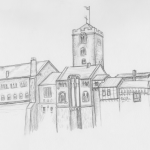Wartburg Castle
Illustration by Montana Johnson
STORY BY LAURA M. FABRYCKY
Whether or not you’re an adherent to the Christian faith, today’s big anniversary marks an event whose effects have been so far-reaching that they helped create the cultural milieu you were born into. Laura Fabrycky’s current abode in Germany—the country in which Martin Luther made his 95 theses public 500 years ago today, on October 31, 1517—has given her a front row view of Germany’s public commemorations of the anniversary of the Reformation. This 16th century religious movement was ultimately marked by the rejection or modification of some Roman Catholic doctrine and practice and by the establishment of the Protestant churches. Laura reflects on how Luther’s work might inspire our own.
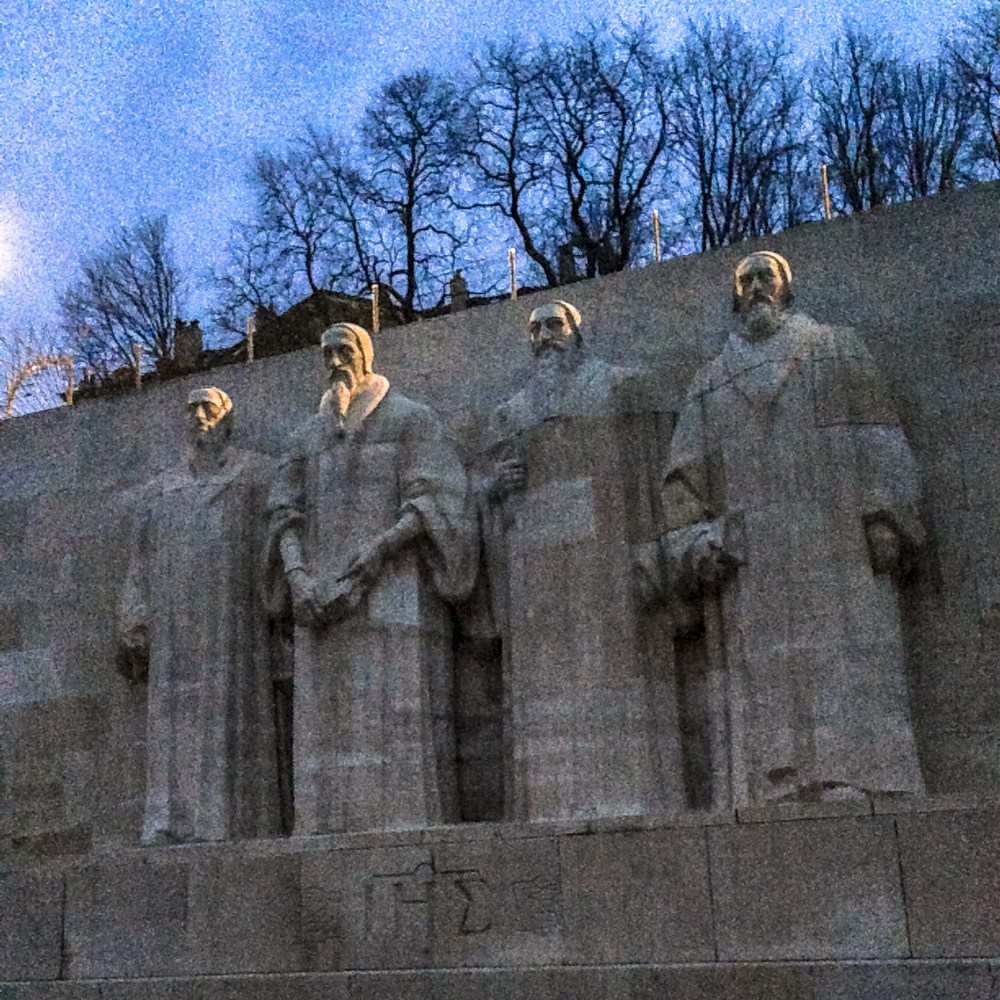
Moving to Berlin, Germany, in the summer of 2016 has afforded me a delightfully close seat to the celebrations of the Protestant Reformation’s 500th anniversary. The open, thoughtful, and very public conversations about Martin Luther and the far-reaching effects of the movement he ignited have been fascinating and illuminating, especially given all I’d heard about Europe’s post-Christian secularism.
The Reformation brought massive changes to the world, but it is rare to explore in such a public way that significant time and its continued relevancy. Through these many exhibits, there is much insight to be retrieved for today, especially regarding what actually brings lasting change to the world, and how it matters to creative labor.
EXHIBITS
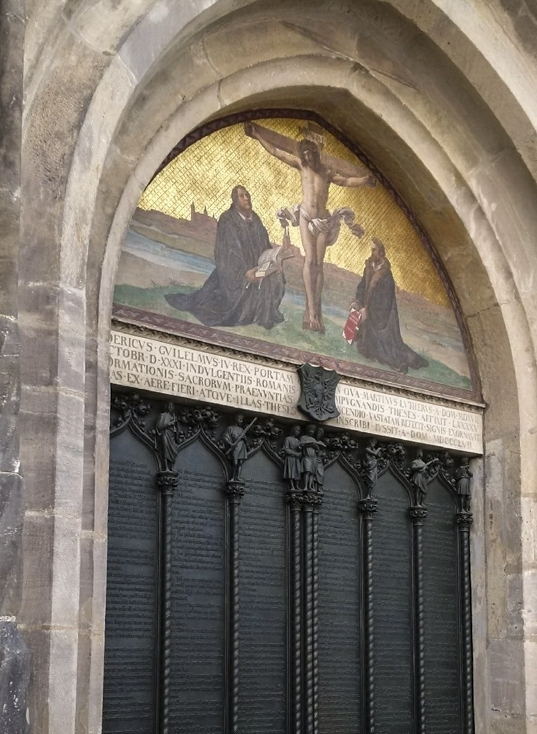
Last summer, during the German government’s annual “open days,” our family visited the German Foreign Ministry to see its various displays, including their outreach efforts to commemorate the Reformation around the world. We gawked at the 3-foot Playmobil figurine of Martin Luther nearby, and managed to get a normally sized one for each member of our family. Interestingly, the figurine has proven to be Playmobil’s most successful in its toy-making history. The little plastic Martin Luther holds two removable objects: a feather pen and a Bible, permanently opened and imprinted with the words: “Das Neue Testament übersetzt von Doktor Martin Luther”—the New Testament translated by Doctor Martin Luther.
Other national exhibits include the Deutsches Historiches Museum’s “The Luther Effect” at the Martin-Gropius-Bau in Berlin, with its incredible double-helix centerpiece that leads to four halls exploring Protestantism in different countries; the “Luther! 95 Treasures, 95 People” exhibit in Lutherstadt Wittenberg; and the “Luther and the Germans” exhibit at Wartburg Castle, perched high above the city of Eisenach.
PARADISE
Additionally, during the fifty-day stretch of time between Easter and Pentecost 2017, large red gates were erected throughout Berlin and elsewhere. These temporary open-air installations were part of a collection called “Das Paradeis ist überall,” exploring the idea of paradise and the persistent ache for heaven in a world where everything has been disenchanted. As the website explains: “Luther developed nothing less than a vision of paradisiacal conditions in the here and now…‘Paradise is everywhere.’ This saying has been attributed to Martin Luther. What does this promise mean to us today? What keeps it from being fulfilled?”
Even today these questions itch us: we still feel shut out of somewhere good, and the door to it seems locked tight. The red gates served as imaginative portals through which an attentive passer-by could get a refracted glimpse of another world right in the middle of this one. They were set up all over the city where paradise beckoned: near döner kebap shops named “Paradeis,” in front of historic churches, and near botanical gardens, signposts to a shared memory of paradise, lost.
But who talks about paradise these days in public, really? It’s a word reserved for advertising, the professional peddling of answers to our dissatisfactions, distractions from a tormenting human itch. Well, Luther spoke of paradise, and so for a time, through these installations, the public was offered a chance to think about it again too.
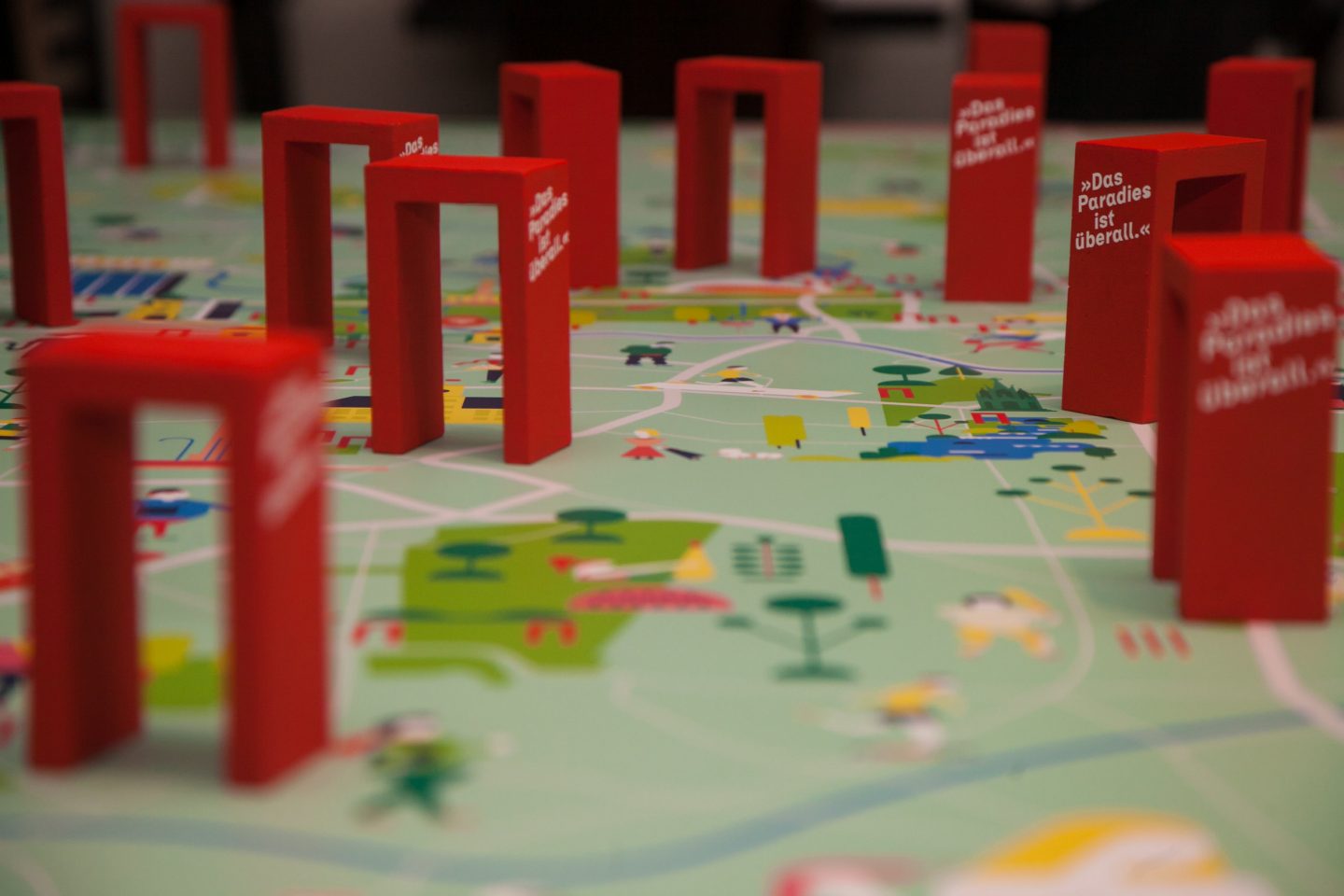
Copyright of the Berlin Culture Project
https://paradiese.berlin/en/press
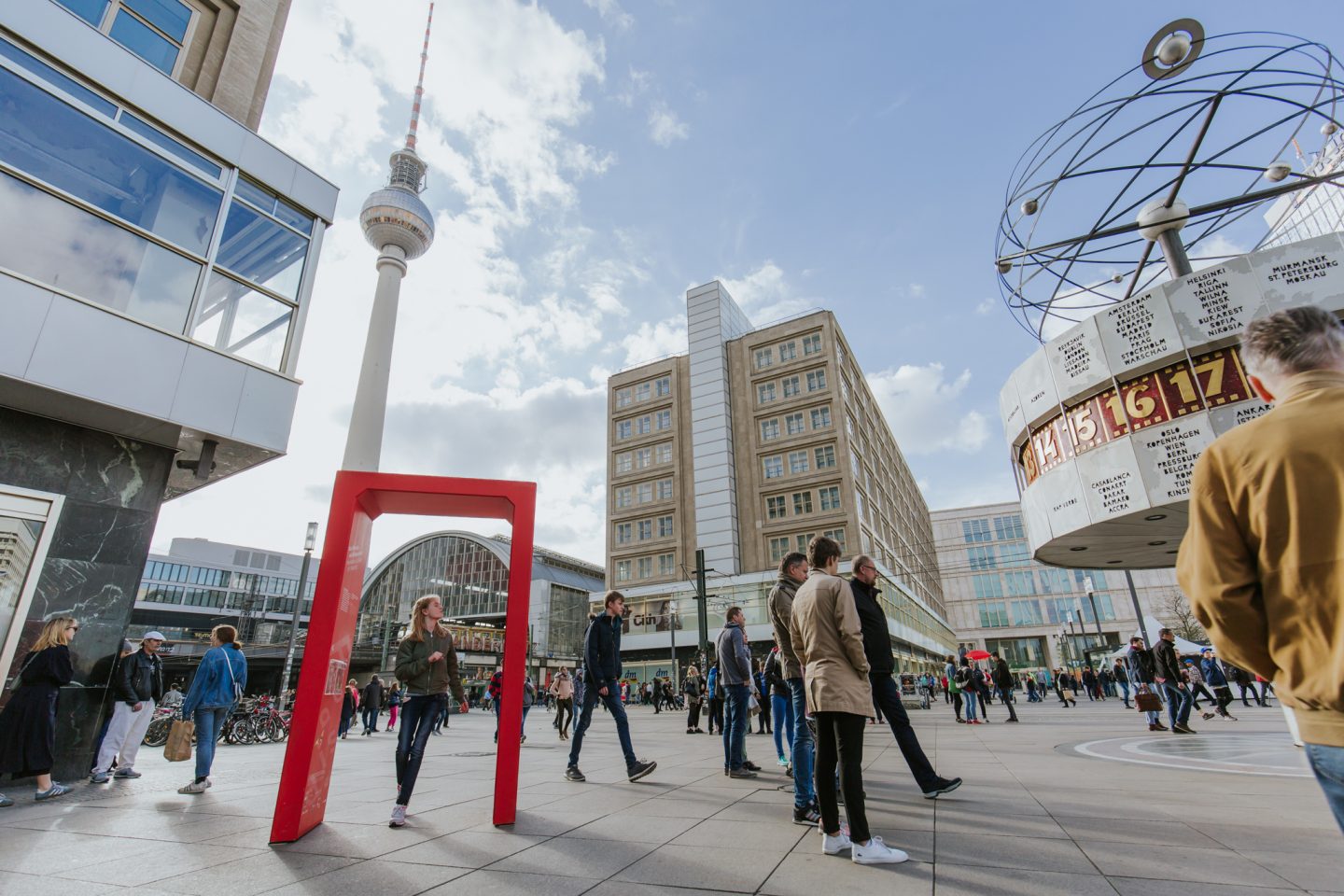
LUTHER AND THE DEVIL
For good and, in some ways, for ill, Luther’s influence on German identity and history is immense. The Economist sought to capture some of those complicated elements of his long shadow in its January 7, 2017, issue. For instance, while some church reformers were suspicious of the artifacts of culture, Luther enlisted the things of this world in his spiritual struggles. He was, for example, an avid musician, and he believed that music was an effective weapon against the devil. Thus, The Economist credits Luther’s indirect influence to the existence of Germany’s 130 publically financed orchestras.
Speaking of the devil these days proves just as precious or pernicious as speaking of paradise, even among the religious. That old enemy of souls is no longer part of our parlance, less so our imaginations. A decade ago while studying in an Episcopal seminary in the United States, I recall some classmates speaking with a kind of intellectual pity for those who continued to refer to the reality of “evil personified.” Taking the devil seriously was evidence of an untamed mind.
Of course, Luther took the devil very seriously, and in the world Luther inhabited, the devil was also überall, busy with his diseased and destructive work. Luther felt he contended with the devil within and without, especially as he wrestled with his unshakable sinfulness and, later, as he labored to make intellectual strides. From our vantage in history, with all our psychological insights, Luther now sounds like a tormented soul, a little unstable in his wiring. His vow to St. Anne for protection in the midst of a terrifying thunderstorm in 1505 was rash. But, saved from the storm—whether one credits St. Anne or not—Luther honored his votive cry and became a monk, rather than a lawyer as he originally planned.
Yet his new occupation exacerbated his fragile wiring all the more. Ever scrupulous, he plunged deeper into self-obsession over his sinfulness and more fearfully into the hands of an apparently angry, aloof God. Despite spiritual counsel intended to assuage him, Luther’s efforts to escape the dark forsaken forest of his soul seemed futile. The world around him also offered no real peace.
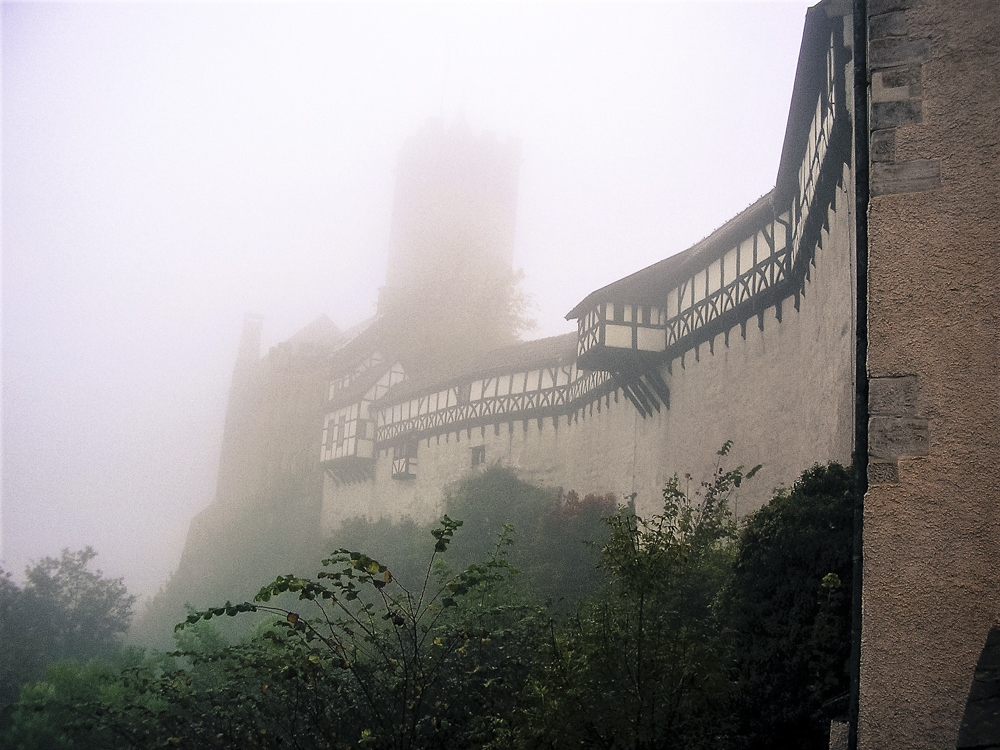
Photos by Raymond Johnson

LIGHT
Still, in that existential darkness, he wrestled, reading, writing, and laboring over the Scriptures. Something was there. A light seemed to shine out from behind a locked door. He banged on it until someone seemed to open it from the other side. A life-giving light broke into dark recesses of Luther’s life.
His chains of internal torment thrown down for a time, Luther felt at peace, ready to take on the theological cancers found in the church and society. Thus he taught, wrote, and engaged in debates. His fame grew, as did his confidence in his new course and the far-reaching ramifications of his discoveries for people everywhere, which led toward inevitable conflict with the powers. And so, he was, at last, excommunicated by the Church, summoned by Charles V to the imperial Diet at Worms, and declared there an outlaw, “the devil in the habit of a monk.” His very life was in jeopardy.
What came next was an odd but critical moment in Luther’s life. Sympathetic to Luther’s situation, the Elector of Saxony, Duke Frederick the Wise, staged a highway kidnapping of Luther in 1521, allowing him to live in his Wartburg Castle to avoid arrest or death. Luther stayed hidden there for a little less than a year. He grew a beard as a disguise and used the name “Junker Jörg,” or Sir George, a particularly apt allusion to a legendary saint who battled a dragon. In an upper room of that lonely castle, Martin Luther, as George, translated the New Testament from Greek into German—from a dead language used only by educated scholars into the people’s language, accessible to all—in the period of not more than ten weeks.
FAMOUS INK STAIN
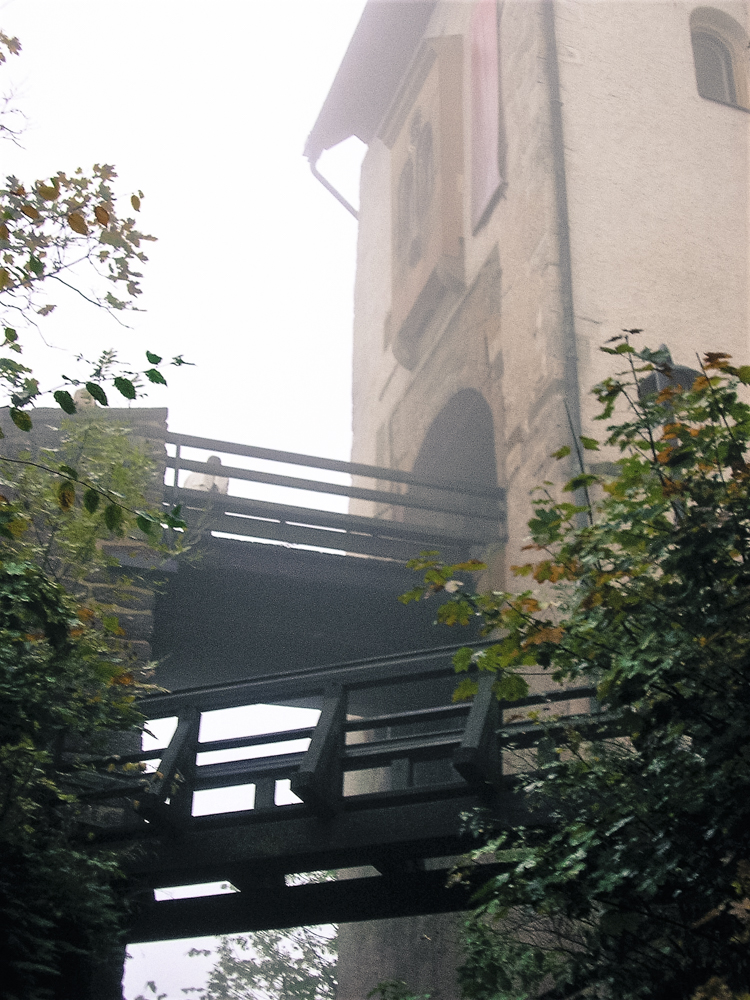
Photo by Raymond Johnson
At Wartburg Castle today, a visitor walks through many beautifully ornate rooms and grand halls that each have a storied history. But the tour’s high point comes at the very end: the small, spare Luther Room with its huge green-tiled oven, a broad wooden desk, and a clunky piece of stone column serving as a footstool.
For many hundreds of years, pilgrims have peered into this room, hoping to see evidence of Luther’s famed ink-stained battle with the devil. The story goes that Luther, so tormented by the devil’s work in myriad frustrating forms—a buzzing fly, distracting noises that kept him awake at night—finally hurled his inkwell at evil, personified, the bottle hitting the wall. Tourists to the castle since 1650 until about a hundred years ago saw a splatter of blue ink on the wall high up behind the oven. Bit by bit, pilgrims and tourists chipped off pieces of wall with the ink. Year after year, the ink splatter was replaced. No one claims this was miraculous.
What becomes clear, though, standing in that room and beholding the desk at which he worked, is that Luther did throw his ink at the devil in that room, and because of it, miracles did occur. Reckoning for every Greek jot and tittle, the devil-in-the-details of translation, Martin wrote, and thereby slid a key into a locked door. Disguised and hidden, Luther labored at the words of the Bible, long locked away from people, about a God who seemed to have been locked away in paradise too.

Library of Congress Prints and Photographs Division
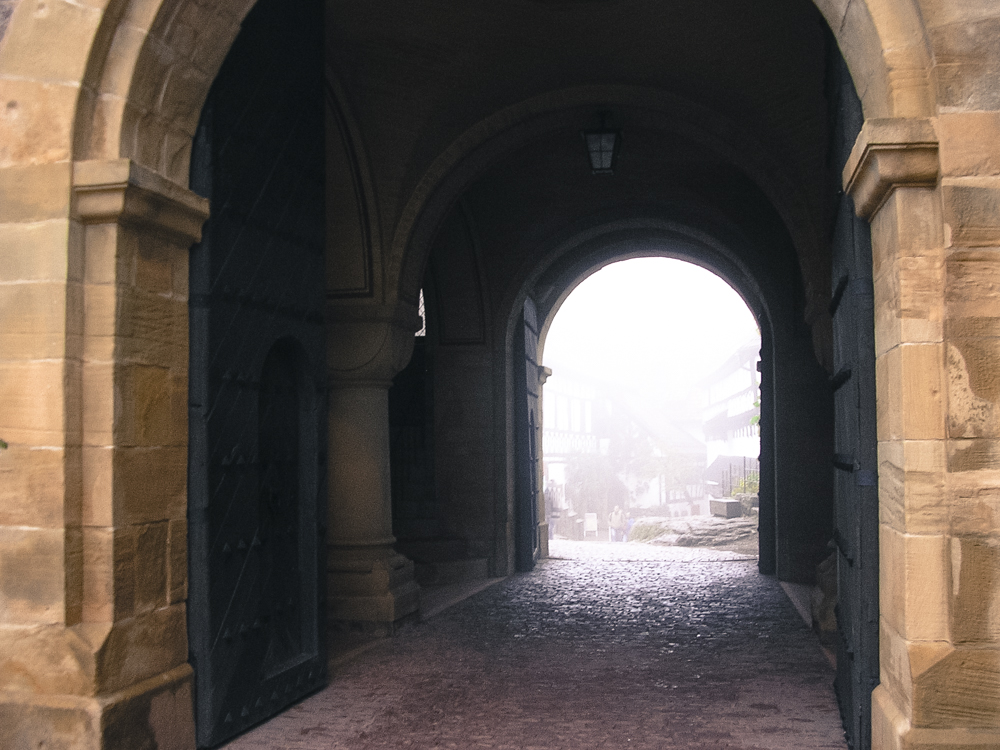
Throwing Light in Dark Corners: Inspiration from Luther
As a writer, while I would never say that I battle the devil himself in the labor of writing, there are certainly times that the routines of life, with all its depressing elements, serve as a proverbial buzzing fly. Infotainment distractions draw me into a deadening, locked-away place. Why chip away at these little words? Why study? Why try? What effect will this really make in the world? Why care at all?
These questions point to a deeper malaise, best named as acedia, a word the writer and poet Kathleen Norris unearthed again for popular parlance and public engagement in her book Acedia and Me. Long dogged by a feeling of being unable to care, an inert indifference to life itself, Norris studied acedia and how one escapes its trap.
Beyond religious cloisters the word itself was lost, making people everywhere all the more susceptible to its quiet, devastating effects but incapable of naming it. Acedia was even dropped from the Oxford English Dictionary in 1933, but regained an entry after World War II, for post-war peace did not bring about a deeper peace to that persistent human ache.
Throwing her own bottle of ink at the murky, life-denying shadows, Norris recovered the word to its important signifying work and unearthed weapons effective against it. Among them, she recommends reciting the Psalms—“The Psalms are just poetry,” she reminds readers—and finding ways to keep caring, to get outside of one’s own self.
Very few of us doing creative work in the world will bring about the kinds of world-changing influence Martin Luther did. We wonder why we should keep at our oft-hidden labors, and we are tempted to answer our inner aches through the countless available numbing distractions.
While none of our creative works can finally bring about a true and only heaven, they most certainly do beguile the devil, that darkness that seems intent on undoing the common good in the world, or locking the good away only for a very powerful few. Our small labors may well light a dark corner for someone trapped in torment.
Yes, Martin Luther was a tormented soul – I know a few and, at times, count myself among them. (Some of his sins also reverberate today, including an anti-Semitism that never seems sufficiently vanquished.) Yet, in the midst of his human complication, Martin Luther brought about monumental good, especially in his hidden, creative work.
For a handful of weeks, alone and devil-tormented, Martin-as-George worked with that pen—now cast for us in Playmobil plastic—throwing his ink at the devil, pointing to the hope of the proximity of paradise. Because of it, the world was changed. So let us too keep throwing ink at the devil; keep finding ways to care and change our world.
Laura M. Fabrycky is an American poet and essayist, and the spouse of a U.S. Foreign Service officer, currently residing in Berlin, Germany, with her family. Her writing has appeared in Books & Culture, Foreign Service Journal, Good Housekeeping Middle East, Topology, and elsewhere. Her first published collection of poetry is Give Me the Word.


